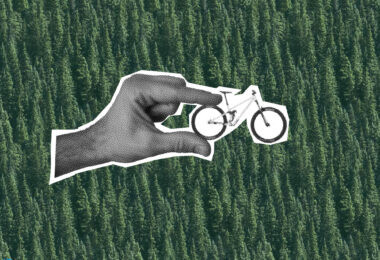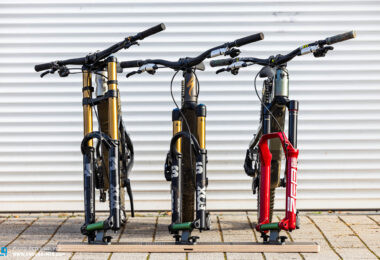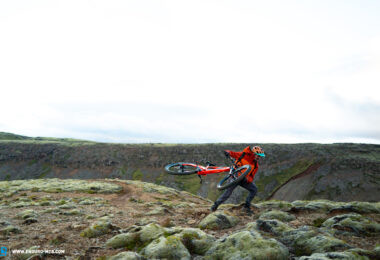Enduro mountain biking is a thrilling discipline that demands a specific type of bike – the Enduro Bike. But what exactly is an enduro bike, and what sets it apart? If you’re diving into the world of mountain biking, particularly the adrenaline-fueled trails of enduro, understanding your bike is paramount. This guide will explore the essential aspects of enduro bikes, drawing insights from the latest trends and reviews in the mountain biking world.
What Defines an Enduro Bike?
Enduro bikes are built for tackling challenging terrains, both uphill and downhill. They are the versatile all-rounders of the mountain bike world, designed to handle technical climbs and then confidently descend steep, rugged trails. Think of them as the rally cars of mountain biking – robust, capable, and ready for anything.
Key Characteristics of Enduro Bikes:
- Suspension Travel: Enduro bikes typically boast a generous suspension travel, usually ranging from 150mm to 180mm. This plush suspension soaks up bumps, rocks, and drops, providing a smoother and more controlled ride on demanding trails.
- Frame Geometry: Aggressive geometry is a hallmark of enduro bikes. Slacker head angles (around 64-65 degrees) provide stability at high speeds and on steep descents. Steeper seat angles, however, ensure efficient pedaling for climbing.
- Robust Build: Durability is key. Enduro bikes are built to withstand the punishment of aggressive riding. Expect strong frames, reliable components, and tires designed for grip and puncture resistance.
- Wheel Size: While 29-inch wheels are increasingly popular for their rollover capability and speed, 27.5-inch wheels remain a viable option, favored by some for their agility and playfulness. Many modern enduro bikes even adopt a mixed “mullet” setup, combining a 29-inch front wheel for stability and a 27.5-inch rear for maneuverability.
Finding Your Perfect Fit: Enduro Bike Sizing
Just like finding the right shoes, bike size is crucial for comfort, control, and performance. A bike that’s too big or too small will not only be uncomfortable but can also compromise your handling and confidence on the trail.

General Size Guide Considerations:
- Reach: This is a critical measurement indicating the horizontal distance from the bottom bracket to the head tube. Reach influences your riding position and weight distribution. Enduro bikes often have longer reach measurements for stability.
- Stack: Stack refers to the vertical distance from the bottom bracket to the top of the head tube. Stack height affects handlebar height and overall rider posture.
- Standover Height: While less critical than reach and stack, standover height (the clearance between the top tube and the rider’s inseam) is still a factor for comfort and maneuverability.
How to Determine Your Size:
- Manufacturer Size Charts: Most bike manufacturers provide size charts based on rider height. These are a good starting point but should be considered a general guide.
- Test Rides: The best way to determine the right size is to test ride different bikes. Pay attention to how the bike feels when climbing, descending, and cornering.
- Professional Bike Fit: For serious enduro riders, a professional bike fit can be invaluable. A fitter will assess your body measurements and riding style to recommend the ideal bike size and setup.
Essential Components for Enduro Performance
Enduro bikes are equipped with components designed to withstand demanding riding and enhance performance.
Brakes: Power and Modulation
Reliable and powerful brakes are non-negotiable for enduro riding. Descending steep trails requires brakes that offer consistent stopping power and excellent modulation (control over braking force). Hydraulic disc brakes are standard on enduro bikes, often with larger rotors (200mm or more) for increased heat dissipation and braking power. Brands like TRP, with their EVO Pro models, are continually pushing the boundaries of brake performance for demanding disciplines like enduro, offering riders increased power and reliability.

Saddle: Comfort for Long Days
While enduro riding is gravity-focused, you still need to pedal uphill to earn your descents. A comfortable saddle is essential for long days on the bike. Enduro saddles often strike a balance between pedaling efficiency and comfort for seated climbing and technical sections. Features like pressure relief channels and durable construction are important considerations.
Storage Solutions: Keeping Essentials Handy
When you’re out on the trail, carrying essential tools, spares, and nutrition is crucial. Efficient storage solutions are a welcome feature on enduro bikes. Fork mount systems for car transport, like the BikeStow, demonstrate the need for hassle-free bike management beyond just riding. While this example is for transport, the principle extends to on-bike storage for rides. Consider frame bags, hip packs, or integrated storage compartments within the bike frame to carry your essentials without hindering your riding.

Exploring the Enduro World
Enduro bikes are your ticket to exploring diverse and challenging landscapes. From bike parks to natural trails, these bikes are built for adventure. Whether you’re shredding downhill runs in Iceland or tackling your local trails, the right enduro bike will enhance your experience.

Conclusion: Embrace the Enduro Bike
The enduro bike is more than just a mountain bike; it’s a tool for adventure, designed to conquer challenging terrain and deliver exhilarating riding experiences. Understanding the key features, finding the right size, and choosing reliable components are crucial steps in embracing the world of enduro mountain biking. As you explore the trails, your enduro bike will be your trusted partner, ready for any challenge the mountain throws your way.
